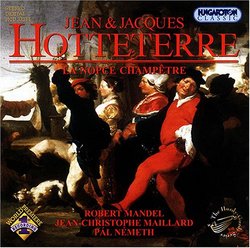| All Artists: Jean Hotteterre, Jacques Hotteterre, Ensemble Berger Fortuné, Agnes Varallyay Title: Jean & Jacques-Martin Hotteterre: La Nopce Champêtre Members Wishing: 1 Total Copies: 0 Label: Hungaroton Original Release Date: 1/1/2006 Re-Release Date: 1/24/2006 Album Type: Import Genres: Special Interest, Classical Styles: Opera & Classical Vocal, Chamber Music, Historical Periods, Baroque (c.1600-1750), Early Music Number of Discs: 1 SwapaCD Credits: 1 UPCs: 675754881429, 5991813233424 |
Search - Jean Hotteterre, Jacques Hotteterre, Ensemble Berger Fortuné :: Jean & Jacques-Martin Hotteterre: La Nopce Champêtre
 | Jean Hotteterre, Jacques Hotteterre, Ensemble Berger Fortuné Jean & Jacques-Martin Hotteterre: La Nopce Champêtre Genres: Special Interest, Classical
|
Larger Image |
CD Details |
CD ReviewsMasterful Musette Richard C. Rutan | Phila, PA | 07/12/2006 (5 out of 5 stars) "There is no instrument which transports me as instantly and completely to realms of Baroque splendor than the Musette. One can bask in the florid glories of Vivaldi and Telemann, or the awesome profundity of Sebastian Bach; yet it is only the Musette through which seeps sunbeams parting thick curtains revealing a room of unimaginable luxury; it is only the Musette which will surround you with the green, plush, velvet regency of a Versailles garden party in the dusk of a summer's evening.
I've longed to hear these releases: Hungaroton's HCD 32102, 32201, & 32334, with Jean-Christophe Malliard on Musette, Robert Mandel on Hurdy-Gurdy, Pal Nemeth on Baroque Flute. Under the name "Ensemble le Berger Fortune", they are backed by pickup groups of Hungarian Baroque specialists, joining them variously on Baroque violins, Viola Da Gamba, Recorders, Cembalo, and Theorbe. Of the many adjectives available to describe these recordings, `labored' and `overworked' simply don't apply. All the musicians exhibit a playful mastery of the idiom through carefully crafted interpretations which never lose freshness. To be precise, the baroque `Musette Royale' or `Musette de Court' is the little bagpipe of 17th & 18th century France. (I'll call it simply the `Musette' here, for clarity's sake). The Musette has been graced with repertoire by Rameau, Chedeville, Campra, Boismortier, all some of the greatest composers in France at that time. In the Hungaroton CD's we hear works of Jean + Jacques Hotteterre, Corrette, and DeLaVinge; which consist mainly of multimovement suites, often with evocative, pastoral titles The earliest extant publications of printed music specifically for the bagpipe (any bagpipe) are those containing music for the musette. Sadly, the Musette's considerable repertoire remains largely unheard today. Without delving too deeply into technical details, the Musette is a small, bellows-blown bagpipe (as opposed to being inflated by mouth) somewhat in danger of being overpowered by a string quartett. Its drone system is modeled on an instrument called the Rackett, whose bore doubles over and over again in order to shorten the drone's total length. In addition to having a completely chromatic chanter (through use of keys like the flute or oboe), there is a secondary chanter, extending the range into two octaves, which sounds only when a note's particular key is pressed open (like the pipe organ). Capable of droning in many tonalities, the Musette is able to play what violinists call `double stops', allowing as full a usage of tonal resources as any bagpipe has ever known. Maillard's performances on Musette are free and easy. By drawing on his dual training in classical Flute & Breton piping, he simultaneously imparts to the Musette both the Flute's characteristic transparency and the Pipe's pungent earthiness. The Musette's role in the texture is always melodic; yet it's interplay is conversational, never slipping into the `melody + accompaniment' trap, as pipes are wont to do when involved in mixed groups. With the Hungaroton series, Maillard forges himself a link with the foremost exponents of the French woodwind school: possibly he is the first to do so on the Musette in over 200 years. Even if you're unfamiliar with Baroque, these CD's present no obstacles for entry into the genre. Bagpipers of all ilks can connect with the Musette's moment of glory, when pipes were a welcome and regular participant in the mainstream of composed western art-music. But for the initiated, its like finding a lost chapter to a much loved book you've read far too often. -30- The author will not compensated for this contribution." |

 Track Listings (49) - Disc #1
Track Listings (49) - Disc #1